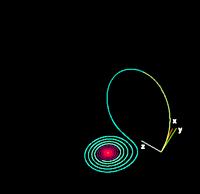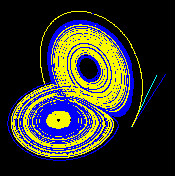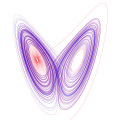# we solve the Lorenz system of the differential equations.# Runge-Kutta's method y_{n+1}= y_n + h*(k_1 + 2*k_2+2*k_3+k_4)/6; x_{n+1}=x_n+h# k_1=f(x_n,y_n), k_2=f(x_n+h/2, y_n+hk_1/2), k_3=f(x_n+h/2, y_n+hk_2/2), k_4=f(x_n+h, y_n+hk_3)# differential equationdefRunge_Kutta(f,v,a,b,h,n):tlist=[a+i*hforiinrange(n+1)]y=[[0,0,0]for_inrange(n+1)]# Taking length of f (number of equations).m=len(f)# Number of variables in v.vm=len(v)ifm!=vm:return("error, number of equations is not equal with the number of variables.")forrinrange(vm):y[0][r]=b[r]# making a vector and component will be a list # main part of the algorithm k1=[0for_inrange(m)]k2=[0for_inrange(m)]k3=[0for_inrange(m)]k4=[0for_inrange(m)]foriinrange(1,n+1):# for each t_i, i=1, ... , n# k1=h*f(t_{i-1},x_1(t_{i-1}),...,x_m(t_{i-1}))forjinrange(m):# for each f_{j+1}, j=0, ... , m-1k1[j]=f[j].subs(t==tlist[i-1])forrinrange(vm):k1[j]=k1[j].subs(v[r]==y[i-1][r])k1[j]=h*k1[j]forjinrange(m):# k2=h*f(t_{i-1}+h/2,x_1(t_{i-1})+k1/2,...,x_m(t_{i-1}+k1/2))k2[j]=f[j].subs(t==tlist[i-1]+h/2)forrinrange(vm):k2[j]=k2[j].subs(v[r]==y[i-1][r]+k1[r]/2)k2[j]=h*k2[j]forjinrange(m):# k3=h*f(t_{i-1}+h/2,x_1(t_{i-1})+k2/2,...,x_m(t_{i-1})+k2/2)k3[j]=f[j].subs(t==tlist[i-1]+h/2)forrinrange(vm):k3[j]=k3[j].subs(v[r]==y[i-1][r]+k2[r]/2)k3[j]=h*k3[j]forjinrange(m):# k4=h*f(t_{i-1}+h,x_1(t_{i-1})+k3,...,x_m(t_{i-1})+k3)k4[j]=f[j].subs(t==tlist[i-1]+h)forrinrange(vm):k4[j]=k4[j].subs(v[r]==y[i-1][r]+k3[r])k4[j]=h*k4[j]forjinrange(m):# Now x_j(t_i)=x_j(t_{i-1})+(k1+2k2+2k3+k4)/6y[i][j]=y[i-1][j]+(k1[j]+2*k2[j]+2*k3[j]+k4[j])/6return(tlist,y)# (Figure 1) Here, we plot the solutions of the Lorenz ODE system. a=0.0# t_0b=[0.0,.50,0.0]# x_1(t_0), ... , x_m(t_0)t=var('t')x=var('x',n=3,latex_name='x')v=[x[ii]foriiinrange(3)]f=[10*(x1-x0),x0*(28-x2)-x1,x0*x1-(8/3)*x2];n=1600h=0.0125tlist,y=Runge_Kutta(f,v,a,b,h,n)#print(tlist)#print(y)T=point3d([[y[i][0],y[i][1],y[i][2]]foriinrange(n)],color='red')S=line3d([[y[i][0],y[i][1],y[i][2]]foriinrange(n)],color='red')show(T+S)# (Figure 2) Here, we plot every y1, y2, and y3 in terms of time.a=0.0# t_0b=[0.0,.50,0.0]# x_1(t_0), ... , x_m(t_0)t=var('t')x=var('x',n=3,latex_name='x')v=[x[ii]foriiinrange(3)]Lorenz=[10*(x1-x0),x0*(28-x2)-x1,x0*x1-(8/3)*x2];n=100h=0.1tlist,y=Runge_Kutta(Lorenz,v,a,b,h,n)#Runge_Kutta(f,v,0,b,h,n)#print(tlist)#print(y)P1=list_plot([[tlist[i],y[i][0]]foriinrange(n)],plotjoined=True,color='red');P2=list_plot([[tlist[i],y[i][1]]foriinrange(n)],plotjoined=True,color='green');P3=list_plot([[tlist[i],y[i][2]]foriinrange(n)],plotjoined=True,color='yellow');show(P1+P2+P3)# (Figure 3) Here, we plot the y and x or equivalently y2 and y1 a=0.0# t_0b=[0.0,.50,0.0]# x_1(t_0), ... , x_m(t_0)t=var('t')x=var('x',n=3,latex_name='x')v=[x[ii]foriiinrange(3)]f=[10*(x1-x0),x0*(28-x2)-x1,x0*x1-(8/3)*x2];n=800h=0.025tlist,y=Runge_Kutta(f,v,a,b,h,n)vv=[[y[i][0],y[i][1]]foriinrange(n)];#print(tlist)#print(y)T=points(vv,rgbcolor=(0.2,0.6,0.1),pointsize=10)S=line(vv,rgbcolor=(0.2,0.6,0.1))show(T+S)# (Figure 4) Here, we plot the z and x or equivalently y3 and y1 a=0.0# t_0b=[0.0,.50,0.0]# x_1(t_0), ... , x_m(t_0)t=var('t')x=var('x',n=3,latex_name='x')v=[x[ii]foriiinrange(3)]f=[10*(x1-x0),x0*(28-x2)-x1,x0*x1-(8/3)*x2];n=800h=0.025tlist,y=Runge_Kutta(f,v,a,b,h,n)vv=[[y[i][0],y[i][2]]foriinrange(n)];#print(tlist)#print(y)T=points(vv,rgbcolor=(0.2,0.6,0.1),pointsize=10)S=line(vv,rgbcolor=(0.2,0.6,0.1))show(T+S)# (Figure 5) Here, we plot the z and x or equivalently y3 and y2 a=0.0# t_0b=[0.0,.50,0.0]# x_1(t_0), ... , x_m(t_0)t=var('t')x=var('x',n=3,latex_name='x')v=[x[ii]foriiinrange(3)]f=[10*(x1-x0),x0*(28-x2)-x1,x0*x1-(8/3)*x2];n=800h=0.025tlist,y=Runge_Kutta(f,v,a,b,h,n)vv=[[y[i][1],y[i][2]]foriinrange(n)];#print(tlist)#print(y)T=points(vv,rgbcolor=(0.2,0.6,0.1),pointsize=10)S=line(vv,rgbcolor=(0.2,0.6,0.1))show(T+S)






























































